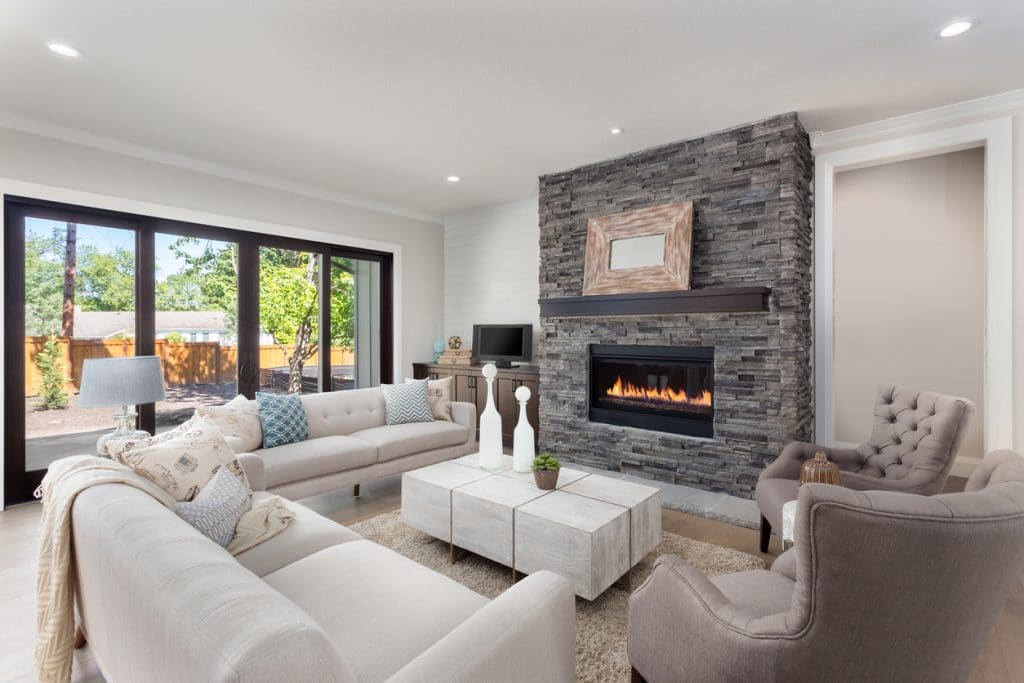A cozy hearth can make a house feel like a home, but a traditional fireplace does not give a house a great Home Energy Score. In this blog post, we stack up the options for keeping, replacing or removing your fireplace and how that might impact your home’s efficiency and market value down the road.
Traditional Wood-Burning Fireplace: Pros and Cons for Portland
A study by the National Association of Realtors found that home buyers are willing to pay more for a home with a fireplace — up to 12% more than comparable homes. In 2016, Angie’s List surveyed consumers and found that fireplaces are equated not just with coziness but also luxury. They also discovered that 60% of home buyers prefer wood-burning fireplaces above gas or electric.
In Portland, that might not be the case too much longer. Because wood-burning fireplaces are a notorious source of air leaks, they may actually decrease energy efficiency overall. That’s bad news on your Home Energy Score assessment.
The U.S. Department of Energy estimates that about 300 cubic feet of air per second is sent directly up the chimney when a wood-burning fireplace is in use. Fires require air to burn, and they draw it from the surrounding room, creating the equivalent of three bathroom fans running to suck air out of your home. The net effect is that burning a fire in a traditional open-hearth fireplace can actually cool a room, not heat it! At best, this kind of fireplace obtains about a 30% efficiency rate, meaning 70% of heated air goes directly up the chimney. Not only that, but the problem continues when the fireplace is not in use. Even with a glass door on the hearth, warm air from your home can enter the flue through cracks around the door or in the masonry, go up the chimney and escape into the atmosphere.
It’s no wonder that the Department of Energy hates traditional fireplaces and recommends that they be decommissioned and the chimney filled with insulation for better Home Energy Scores. So what are the alternatives?
Fireplace Inserts
These options require professional installation, which includes relining the chimney to ensure safe venting of the fire. However, they may be the best way to capitalize on fireplace buyer appeal while eliminating some of the efficiency problems of the old system.
- Gas insert. These units fit snugly into your existing fireplace masonry to eliminate any air leaks. They burn propane or natural gas with a cheerful flame and provide efficiency rates of up to 70% (meaning 70% of heated air is returned to the home). Gas-fueled flames traveling through glowing ceramic logs, and many feature an energy-saving electric ignition. However not all may be compatible with your existing flue; have a professional installer check to see if your chimney will support a gas insert. Units are available for anywhere from $2,000-$5,000, but the cost of running the gas line to the fireplace and relining the flue to meet safety standards will be in addition to that.
- Pellet stove or insert. Pellets can seem like the ideal compromise between gas and wood fireplaces — they provide heat with renewable wood-based energy but are cleaner and faster to get going than a log fire. Pellet inserts seal off the air leaks around a masonry fireplace much like gas units do, and can obtain efficiency rates of up to 83%, according to the EPA. Another option is a pellet stove, which looks very similar to a wood stove but sits outside the fireplace and can be vented up through the flue as well. Both versions burn wood pellets that can be purchased in bags and poured into the hopper as needed to fuel the fire. Usually, just like with a gas insert, relining the chimney is necessary to run a pellet stove. Units are in the same price range as gas inserts, but you won’t need to figure in the extra cost of running a gas line to the unit.
- Electric fireplace. Though they technically lack a real flame, electric fire look-alikes have improved vastly over the past ten years. Just like a gas fireplace insert, you can buy them to sit inside your existing fireplace. Electric fireplaces don’t need vents or flues, and the chimney can be sealed and insulated to solve the air leak problem. Units are inexpensive and they can be plugged into the wall or connected to the home’s electrical circuit in the wall itself. On the other hand, electric units are more for aesthetic appeal and don’t do much more to heat a room than a space heater would, so buyers might not be willing to pay more for them.
Removing the Fireplace — Best Option for Portland?
Check out a website like House Beautiful and you’ll find all kinds of ingenious uses for fireplaces that don’t involve heat or fire. Storage closets, minibars, entertainment centers, even a reading nook for kids are all possible with a creative touch. What are the advantages?
- Seal off the flue. Eliminate a major source of air leaks and your home will feel cozier and more comfortable — almost as if you’ve got a fire going. Not to mention the boost on your Home Energy Score when they check your home for airtightness.
- Remove the chimney. Portland is in a hazard zone for earthquakes. The unreinforced masonry chimneys in many homes pose a hazard when the ground shakes. Most geologists agree — it’s not a matter of if the Big One will happen, but when. Read more about how to tell if your chimney is safe here.
- Add a feature home buyers will love. Yes, buyers’ ears generally perk up when you mention “fireplace”. But, according to the NAR, other keywords are just as if not more important in a home listing: “storage”, “updated” and “efficient”. Now that we have the Home Energy Score, the traditional fireplace look might not be worth the efficiency hit.
- Save money. Fireplace inserts are expensive to buy and install, but sealing off the flue is an easy DIY project that can be done for under $500. And, according to the U.S. Department of Energy, by sealing and weatherstripping fireplaces, a typical home owner can reduce air leaks by up to 14% and save as much as $275 a year.

